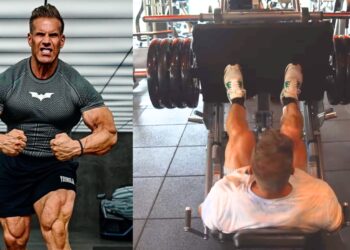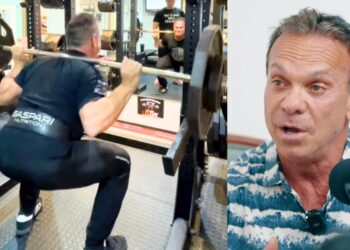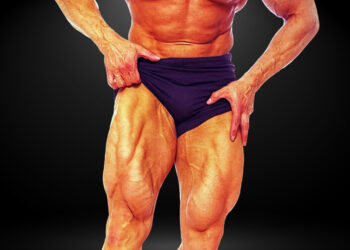Knee pain is undoubtedly the biggest limiting factor when it comes to the ability to effectively train legs, or more specifically, the quadriceps.
But if you’re training every other body part, you want your quads to match because they contribute to a large part of your lower body appearance and strength.
And even if you do suffer from knee pain or have had some type of injury, there are many great workarounds to avoid having lagging quads (thank goodness).
So, let’s break out some effective training methods and exercises to optimize results without the pain. But first, we’ll go over the common knee issues so that you can have a better understanding of how to apply effective training methods safely…
Common Knee Issues
Lots of people suffer from knee issues whether minor or more severe. And whether you’re an athlete or someone who desires to just build bigger and stronger quads; you have to make your training work for you.
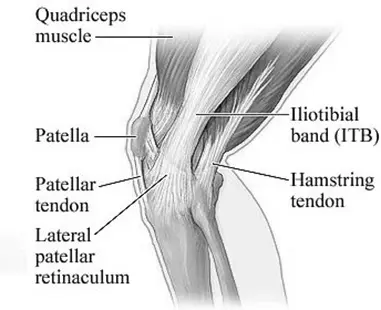
Now, there are some exceptions to whether or not you should be looking for other methods to train legs.
Level Up Your Fitness: Join our 💪 strong community in Fitness Volt Newsletter. Get daily inspiration, expert-backed workouts, nutrition tips, the latest in strength sports, and the support you need to reach your goals. Subscribe for free!
For instance, if you can barely walk or you have no mobility or function whatsoever, which in that case; therapy and/or possibly surgery makes the most sense.
But if there’s still life in your knees or you just want some great exercises to use, you can train safely and effectively by making some adjustments to your technique.
And we’ll get into that shortly, but there are many reasons why you may have knee issues…
The most common reasons include:
- ACL injury
- Arthritis
- Meniscus tear/issues
- patellar tendonitis (due to flat feet, etc)
- Muscular imbalance
Let’s talk about the anatomy of the knee and the commonly associated issues…
Anatomy Lesson
Knee
The knee is, in fact, one of the largest joints in the human body which is made up of the femur (thighbone), tibia (shinbone) and patella (kneecap).
Tendons connect the bones to the muscles of the leg which move the knee joint and the ligaments join the bones which help to stabilize the knee.
ACL
The ACL (anterior cruciate ligament) is a major ligament that helps to stabilize the knee joint and it connects your thigh bone to your shinbone.
And most often, injuries of this ligament occur from aggressive physical movement/s performed during sports or other similar, high-impact/athletic activities. (1)
Meniscus
The meniscus consists of two wedges made of tough and rubbery cartilage which act as shock absorbers between the thigh and shinbone. And it helps to stabilize the joint.
Injury of the meniscus often occurs from twisting and rotating the knee which will make it hard for you to fully extend your knee. (2)
Patella
The patella, also known as the kneecap is a freestanding bone that sits between the femur and tibia; which form a protective layer for optimal movement.
And it functions to allow the thigh muscles to perform movements like running, kicking, and jumping.
Now, patellar tendonitis or jumper’s knee occurs when there’s an injury in the tendon which connects the kneecap to the shinbone. And the injury most commonly occurs in people who do a lot of repetitive jumping.
Although, this isn’t always the case.
Arthritis
Arthritis is inflammation of the joints which is very common in the knee and you’ll often feel stiffness, plus swelling and pain with the disease.
And there are several kinds of arthritis to be aware of which are caused by either wear and tear to the joint’s cartilage (osteoarthritis), autoimmune disease (rheumatoid arthritis), or prior injuries (posttraumatic arthritis). (3)
Best Ways To Train Effectively And Protect Your Knees
Training your quads is never a simple process whether or not you’re dealing with knee pain/issues. But to protect the knee joint and maximize your ability to train your legs, you do need to keep a few things in mind.
So, we put together some great tips and exercises courtesy of Jeff Cavalier (Athlean X) MSPT, CSCS; that you can use effectively, to not only build bigger quads but to make them stronger and maximize their functionality as well.
Check out the video below…
Must-Have Training Tips
Keep Your Shins As Vertical As Possible
Too much forward knee flexion with a heavyweight load during an exercise is not good for all of the common knee issues. But when you keep your shins more vertical throughout a movement, you avoid the flare-ups or reinjury of the area.
And maintaining a vertical shin position is crucial for ACL issues when it comes to promoting knee stability and avoiding too much forward movement of the tibia; which is no longer controlled on the femur.
But it’s also necessary for those with arthritis, meniscus problems, and patellar tendonitis because you don’t want excessive stretching of the joint and pressure which can be very problematic overall.
Level Up Your Fitness: Join our 💪 strong community in Fitness Volt Newsletter. Get daily inspiration, expert-backed workouts, nutrition tips, the latest in strength sports, and the support you need to reach your goals. Subscribe for free!
Reduce The Depth of An Exercise
Exercise depth is another important factor to consider for optimum leg training while dealing with one or more of the common knee issues experienced.
But making sure, avoid too much depth is most important for those with arthritis or a meniscus tear. And the great thing is, you still get the benefit of training legs even without having to go too deep.
You want to be especially careful with certain exercises like the squat which can cause excessive bending of the knee to prevent further pain or tearing of the meniscus.
Best Exercises To Use For Knee Issues
Note: Not every exercise will work for everyone as with anything in life. But these are viable options for people who suffer with knee issues. So, with that being said, try an exercise and see how it works for you.
Reverse Lunge
The lunge is an excellent exercise period but it can also place a lot of stress on your kneecap if not done correctly.
And the forward lunge more specifically, often results in the shin moving too far forward over the feet and this is bad for someone with patellar tendonitis.
So, the reverse lunge is a great alternative because the shin ends up in a more vertical position and the opposite knee being positioned behind the body prevents the movement from potentially going too far down.
The Deadlift And/or Box Squat
The back squat is one of the best lower body exercises you can do to build big, strong, and functional legs. But it’s definitely not for everyone. But an amazing movement to swap it out for is the barbell deadlift.
The deadlift is a beast of an exercise for training the legs/quads and there’s very little forward movement of the shins if done properly.
But this compound movement is also an amazing alternative because you can really load up the bar with maximum weight to overload the quads.
And the box squat is another great exercise that is ideal for people who have arthritis or meniscus issues because it allows you to control the depth while also preventing excessive forward displacement.

Utilize The Bulgarian Split Squat
The Bulgarian split squat is an amazing exercise for building muscle and strength but you also get the unilateral benefits due to training one side at a time which is a more functional way to train.
But you can also train relatively heavy with this movement which is another great benefit.
But the key to doing this movement effectively is keeping your foot positioned to where your shins remain vertical and maybe even slightly back as possible. So, you want to place your leg a little farther out away from the bench.
Step-Ups
The step-up is another great functional unilateral movement that is underrated. And it’s much easier to keep your shin in a vertical position with this exercise too.
The step-up also allows you to train through a larger range of movement and you get plenty of glute and hamstring activation as well.
But if you look at the movement as performed in the video, it would be rather difficult for the shin to move too far forward if you’re doing the exercise correctly.
And if you’re looking to train for more explosiveness even with knee issues, you can do so as shown in the video.
So, it’s a good idea to incorporate more step-ups in your routine for its many benefits.
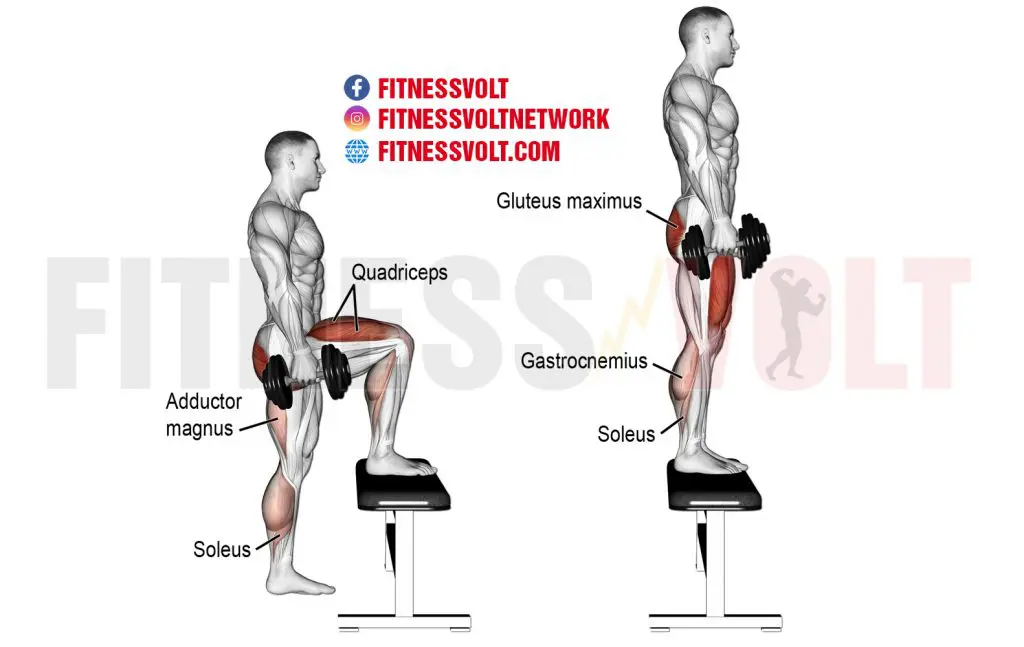
Example Quad Workout
The warm-up is an essential component of any exercise routine and doing so thoroughly is especially important for those with knee issues.
So, start off with an exercise like the reverse lunge with only your bodyweight for 10-12 reps or so, and then do one more set with around 30-40% of your one-rep max before doing the actual workout.
Rest for about 45 seconds between sets and take each set to near failure.
Reverse lunge
- 3 sets x 12-15 reps
Box Squat or deadlift
- 3 sets x 12 reps
Step-ups
- 2 sets x 12 reps
Final Thoughts
Effective quad/leg training doesn’t have to be a painful process if you’re struggling with knee issues unless your case is more severe than most.
And fortunately, there’s so much great information that we have access too when it comes to finding feasible alternatives. It stinks to not be able to train how you want to when you’re dealing with pain and/or prior injuries that haven’t healed properly.
So, just be mindful of proper body position and utilize these very useful exercises and you’ll be able to keep up.



